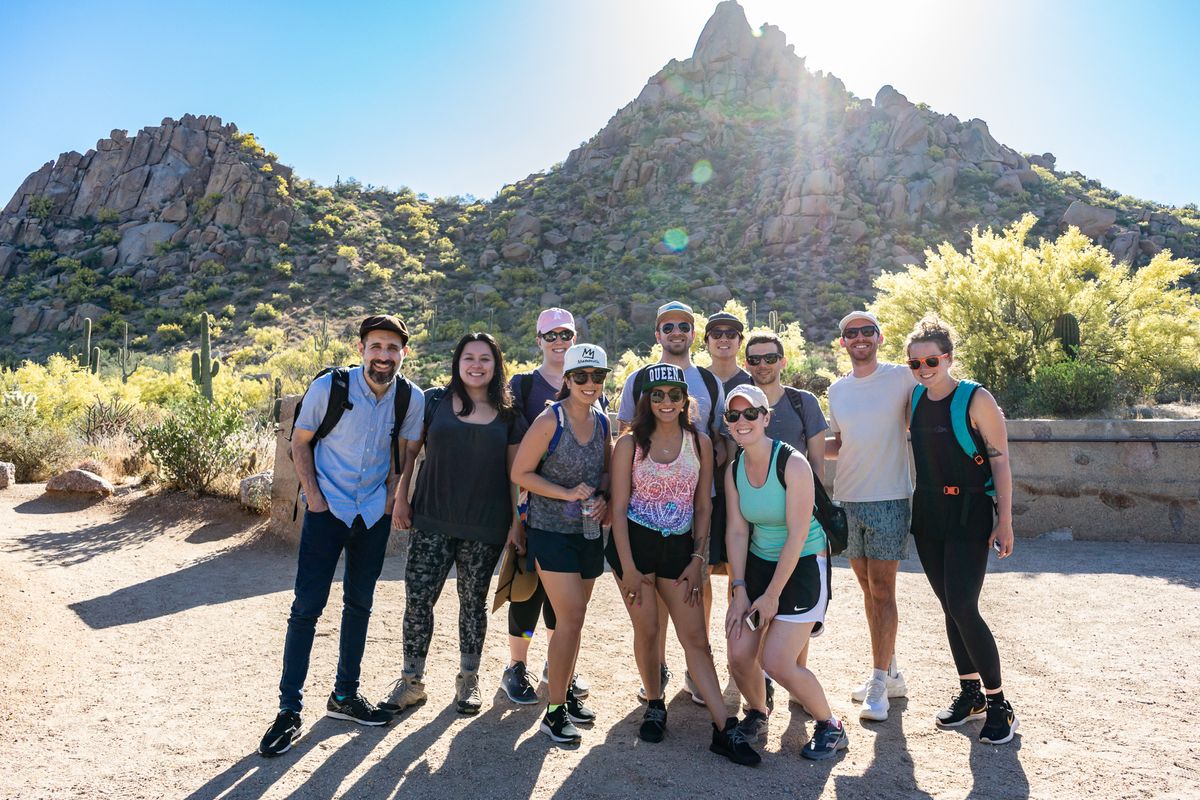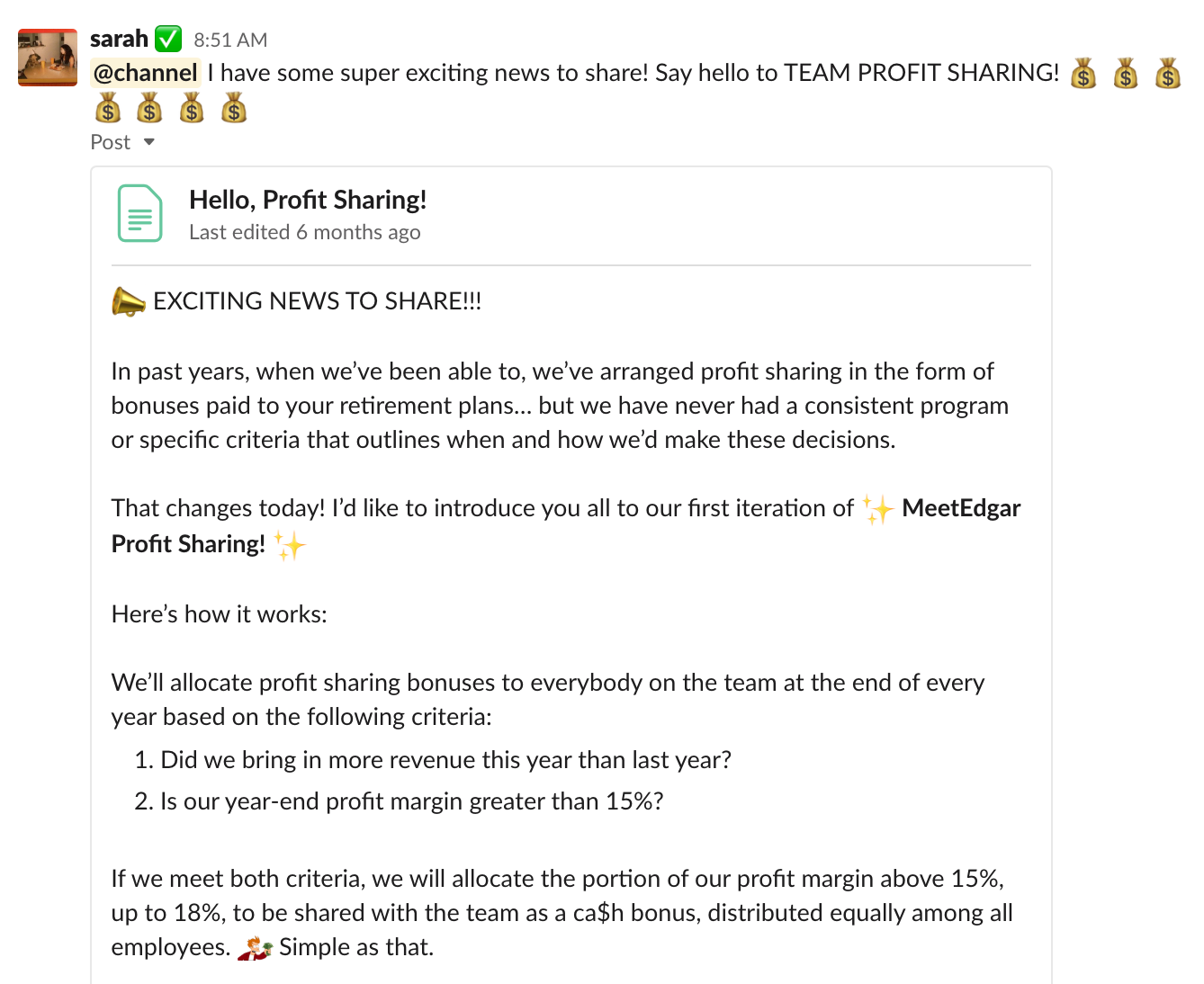Steal this profit sharing plan
The details behind MeetEdgar's new profit sharing plan.

MeetEdgar’s a bootstrapped business. If we don’t have profit, we don’t have a future. If you own your business, you feel this already on a deep, visceral level.
But for your salaried employees, adding more margin for your company isn't all that intrinsically motivating – at least not after a certain point. Once everybody's being reliably paid well and on time, you're able to keep salary increases coming, and you can afford to pursue exciting new projects your team's eager to dive into, does an individual team member really see the difference from a profit margin increase from, say, 16% to 17%?
Profit margin improvements are more abstract and far removed from any individual team member than you think. Even for the hardest working and most internally motivated person, it's hard to justify why it's worth the extra hustle, when there's not much visible difference in the day to day.
It's not about work ethic. It's about Value For Value.
About six months ago, I started hunting for companies with simple, employee-focused profit sharing, hoping for some inspiration. I wanted to find a non-bullshitty way to tie business wins into something that more explicitly benefits and acknowledges the people creating that value. Honestly, I got nowhere.
So... instead, I made my own. As it turns out, simpler was better for us right now. The added benefit of that is that it's easy to understand, easy to adapt, and easy to steal!

Here's how it works
When the dust settles at the end of the year, we’ll determine:
- Did we bring in more revenue this year than last year?
- Is our year-end profit margin greater than 15%?
If we meet both criteria, we’ll split up the portion of our profit margin above 15% up to 18% and share it with the team as a cash bonus, distributed equally among all employees.
That’s it.
It’s stupid simple. That’s what I like about it. But it’s also heavily catered specifically to this team in this moment. Here are some details about the moving parts so you can adapt this better to your situation:
1. We have to bring in more revenue than the previous year
Profit isn't the whole picture. We're a growing business and we aren't anywhere near done yet! This criterion rewards the team for choosing healthy, sustainable revenue growth instead of focusing solely on producing profit by figuring out how to spend less money all year.
2. The company keeps the first 15% of profit margin
The first 15% of our year-end profit margin goes into the business’ bank account as operating cash for the company. In short, it keeps the lights on, our paychecks paid, and our customers thriving for the foreseeable future.
3. There’s an 18% ceiling
After the first 15% of profit margin, any additional profit up to 18% gets added up into a big ol’ profit share pool to be split among employees.
The limit at 18% is really specific to how MeetEdgar’s doing today and is likely the first thing to evolve in the future. Right now, we’re eager to get onto a steady, reliable growth trajectory — so deploying additional cash to fuel new growth projects and experiments is a huge help!
This limit encourages us not to hoard money. It makes sure we're encouraged to grab opportunities throughout the year to reinvest back into the business' growth – which of course leads to more potential profit share payments in the future.
4. We split the profit share pool evenly
I researched sooo many bonus programs and through it all, I couldn't find a single convincing argument against this.
Many companies include performance assessments and salary as an element of their bonus programs. One problem there: the profit we create together happens because of every single person’s contributions — no matter their salary and no matter what type of performance feedback they've been working to address throughout the year.
🗯️ So your salary's higher than everyone else's on the team? The benefit of that that is that your salary is higher than everyone else's on the team.
🗯️ You've worked here more years than everyone else? Nice! I hope that means you'll be around for more of these payouts over time than people who join later.
🗯️ Somebody you manage isn't performing well? If they're still here and improving, they're doing well enough to be acknowledged as a contributing member of the team.
Our results are the cumulative total of all of our efforts (for better and for worse). When the company does well as a result of our work, we all win as one team.
This is only the first iteration of Profit Sharing at MeetEdgar, and it’s long overdue. I know it’s unlikely that we got it perfect the first time around. I’m sure a few successful pay-outs (or near misses!) will influence this policy as we go, as will the ideas I hear from my team and others.
I’d love for you to share what you think! Have you given something similar a try at your company or been a part of a program you loved? Tell me about it on twitter.
